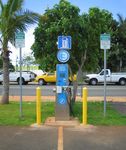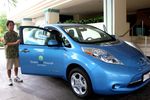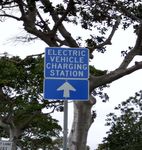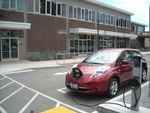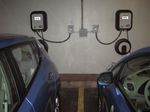HAWAII EV READY Guidebook for Commercial Electric Vehicle Charging Station Installations
←
→
Page content transcription
If your browser does not render page correctly, please read the page content below
HAWAII EV READY
Guidebook for
Commercial Electric Vehicle
Charging Station Installations
May 2012
prepared byAcknowledgements
This Guidebook for Commercial Electric Vehicle Charging Station Installations was produced
from funding made available from the American Recovery and Reinvestment Act (ARRA) of 2009.
These funds are directed for use in the Hawaii State Energy Program through the U.S. Department of
Energy, and support the goals of the Hawaii Clean Energy Initiative (HCEI), a partnership launched in
2008 between the State of Hawaii and the U.S. Department of Energy (DOE). This material is based
upon work supported by the Department of Energy under Award Number DE-EE0000095.
This Guidebook was prepared by Plug In America (PIA) for the State of Hawaii under the Hawaii EV
Ready Grant Program. Plug In America would like to thank Mr. Jim Helmer of LightMoves for his
participation in this project. Plug In America and the Hawaii Department of Business, Economic De-
velopment and Tourism (DBEDT) would also like to give special thanks to the following organiza-
tions and individuals for their input and participation in the development of these guidelines:
Hawaii, Honolulu, Kauai, and Maui Counties Honolulu Clean Cities Coalition
State of Hawaii Department of Health (DOH) IBEW Local 1186, Hawaii
Hawaii State Department of Transportation (DOT) University of Hawaii, Parking and Transportation
Services
Hawaiian Electric Company (HECO)
AeroVironment, Inc.
Electric Auto Association, Hawaii Chapter
Better Place Hawaii
Hawaii Auto Dealers Association (HADA)
Enterprise Holdings, Inc.
Building Industry Association of Hawaii
EZ EV Options
Community Associations Institute, Hawaii Chapter
GreenCar Hawaii, LLC
Hawaii Hotel and Lodging Association
Volta Charging
Hawaii State Building Code Council
Disclaimer
This document was prepared by Plug In America as an account of work sponsored by the State of
Hawaii Department of Business, Economic Development and Tourism. Neither Plug In America
nor the Hawaii State government nor any agency thereof, nor any of their employees, makes any
warranty, express or implied, or assumes any legal liability or responsibility for the accuracy, com-
pleteness, or usefulness of any information, apparatus, product or process disclosed, or represents
that its use would not infringe privately owned rights. The views and opinions of authors expressed
herein do not necessarily state or reflect those of the United States or any agency thereof.
Reference herein to any specific commercial product, process or service by trade name, trademark,
manufacturer, or otherwise does not necessarily constitute or imply its endorsement, recommenda-
tion, or favoring by Plug In America or the Hawaii State government or any agency thereof.
i Hawaii EV Ready Guidebook for Commercial Electric Vehicle Charging Station InstallationsExecutive Summary The Guidebook for Commercial Electric Vehicle Charging Station Installations presents an organized methodology for planning, installing, and operating electric vehicle charging infrastructure at commercial facilities in Hawaii. Hawaii-specific installations are featured throughout the Guidebook. However, the recom- mended order of topics and best practices contained in this Guidebook are applicable any- where in the world where electric vehicles (EVs) can be expected to play a role in the transportation system. The essential premise of this Guidebook is that successful charging station outcomes result from a prescribed process that includes planning, best installation practices, and implementa- tion of an operating plan. By following the recommended course of study in the Guidebook, site hosts will be able to make informed decisions at each step in the process of installing charging stations at their facilities. A comprehensive listing of charging business models is included to help property owners and operators evaluate the financial aspects of funding and operating charging stations. State-of-the-art recommendations on charging station signage, accessibility, and multiple unit dwelling installations are also included in the Guidebook. The recommendations and practices in this Guidebook are based upon millions of miles of real-world EV driving experience, including fueling from both private and public charging stations. Plug In America additionally draws from its professional experience advising gov- ernment agencies, organizations, and businesses on the subject of EV charging infrastructure.
Table of Contents Introduction 2 About This Guidebook .................................................................................................... 2 Background ................................................................................................................... 3 Hawaii’s Leadership ...................................................................................................... 3 Electric Vehicles in Hawaii ............................................................................................ 4 Charging Electric Vehicles ............................................................................................ 6 Planning a Charger Installation 10 Charging Business Models ............................................................................................ 10 What Type of Equipment Should I Choose? ................................................................. 14 Electric Utility Considerations ........................................................................................ 16 Multiple Unit Dwellings .................................................................................................. 17 Choosing an Installer, Contractor, or EV Service Provider ........................................... 19 Obtaining a Permit ......................................................................................................... 21 Installing a Charging Station 22 Selecting a Location for Charging ................................................................................. 22 Accessible Chargers ..................................................................................................... 26 Signage ......................................................................................................................... 28 Operating a Charging System 32 Access to Your Charging Station .................................................................................. 32 Maintenance and Oversight .......................................................................................... 33 Data Collection and Reporting ...................................................................................... 33 Commercial Charging Station Project Flowchart ........................................................... 35 Glossary 36 Common Terms ............................................................................................................. 36 Acronyms ...................................................................................................................... 37 Resources 38 Electric Utility Company Contact Information ................................................................ 38 County Permitting Agencies for Charger Installations ................................................... 39 Publications and Reports .............................................................................................. 40 Organizations ................................................................................................................ 40 Appendices 41 Appendix A: Hawaii Electric Vehicle Legislation and Laws ........................................... 41 Appendix B: Charging Level Standards ....................................................................... 43
Introduction This Guidebook is targeted to owners and operators of commercial properties interested in installing electric vehicle charging stations in Hawaii. Charging locations include businesses, retail stores, hotels, multiple unit dwellings (apartments, townhouses, condominiums) and both privately and publicly owned parking lots. Users of public EV charging infrastructure come from all walks of life, including employees, customers, tourists, fleet operators, and the general public. While the majority of EV charging will take place at home or the workplace, public charging stations can significantly increase the utility and comfort factor of electric vehicles for many drivers by providing a means to extend the range of the vehicle. About This Guidebook Successful charging station projects are the result of an orderly process of planning and installation, as well as the implementation of sound operating practices. To this end, topics in this Guidebook follow an intentional and logical flow. Starting at the beginning and working through the various aspects of electric vehicle charging in the order presented will enable you to follow best industry practices and to make good decisions during the course of your project. A summary flowchart depicting the process of planning, installing, and operating EV charging stations at commercial sites is shown on page 35. The most efficient route to getting a charging station in place is to follow the steps in this Guidebook, as summarized in the flowchart. Note that the online version of the Guidebook includes live links, both to listed webpages as well as to topics within the Guidebook itself. Using your pointing device to choose an entry in the Table of Contents will display that page. Page number references throughout the document are also linked to their locations. Additionally, choosing a step from the flowchart on page 35 will take you to the relevant topic. It is important to keep in mind that the Guidebook has been prepared at a time when laws, regulations and industry practices related to electric vehicles are evolving rapidly, so it is advised to check for updated information and guidelines as they become available to the EV charging industry. An excellent companion resource for electric vehicle owners wishing to install charging equipment at their private residence, the Plug In Electric Vehicle Handbook for Consumers, is available from the U.S. Department of Energy at: www.afdc.energy.gov/afdc/pdfs/51226.pdf Individuals interested in purchasing or leasing an electric vehicle are also encouraged to study EV charging information available from auto dealers, charging equipment providers, your local utility and consumer organizations such as Plug In America. www.pluginamerica.org 2 Hawaii EV Ready Guidebook for Commercial Electric Vehicle Charging Station Installations
Background Hawaii residents have long recognized their overreliance on petroleum-based fuel for trans- portation and energy. This dependency upon oil has created a vulnerable economy heavily impacted by the price of crude oil, most of which is imported from foreign countries. For every barrel of crude oil imported into Hawaii, about one-third is used for ground transporta- tion, one-third for air transportation, and the remaining third for the production of electricity. To help make the shift from petroleum-based fuel, the state partnered in 2008 with the U.S. Department of Energy to create the Hawaii Clean Energy Initiative (HCEI). A goal under this initiative is to reduce oil consumption by 70 percent by 2030 (30% from energy efficiency, and 40% from renewable energy). Attainment of these goals will keep a substantial amount of the nearly $6 billion spent annually on imported oil here in the islands, creating jobs and benefiting the economy. Hawaii’s Leadership Hawaii has been a national leader by adopting policies and laws that promote the use of electric vehicles as a viable means of travel. In 1997, Hawaii was the first state to approve free public parking and single-occupant use of High Occupancy Vehicle (HOV) lanes for owners of elec- tric vehicles. Since then, additional legislation has been passed requiring owners of large public parking facilities to install EV charging equipment, government agencies to procure vehicles less reliant on petroleum-based fuels, and provisions making it illegal to prevent a person from installing EV charging equipment in a multiple unit dwelling (MUD) as long as it meets rele- vant safety, design, and insurance requirements. In August of 2010, the Hawaii State Department of Business Economic Development and Tourism (DBEDT) launched an EV Ready Rebate Program for the purchase of commercially available electric vehicles and electric vehicle supply equipment (EVSE, aka “chargers”). This program was made possible with funding provided by the American Recovery and Rein- vestment Act of 2009 (ARRA), from the U.S. Department of Energy (DOE). In March of 2011, DBEDT established an EV Ready Grant Program awarding over $2 million in ARRA stimulus funds for the systematic deployment of charging stations across the state. These complementary programs have the aim of accelerating the adoption of electric vehicles and related charging equipment in Hawaii. This Guidebook was produced with funds from the EV Ready Grant Program. Powering our vehicles with locally-produced renewable energy, lessening vehicle miles trav- eled (VMT) and improving vehicle efficiency standards will continue to drive down Hawaii’s dependence on oil. Utilizing new energy supplies, modernizing the electric grid, and selling EVs and their supporting infrastructure will result in a stronger economy, a cleaner environ- ment and an improved quality of life for all of Hawaii’s people and its visitors. 3 Hawaii EV Ready Guidebook for Commercial Electric Vehicle Charging Station Installations
Factory produced 2002 electric Toyota RAV4 EV in Kaneohe, Hawaii Electric Vehicles in Hawaii Electric vehicles come in all shapes, types, and sizes, ranging from battery electric vehicles (BEVs) that are completely dependent on electricity, to plug-in hybrid electric vehicles (PHEVs) which use a combination of grid electricity and a liquid or gaseous fuel to assist in providing power and extending the range of the vehicle. Hawaii is an ideal environment for electric vehicles. Typical daily commute distances, on the order of 25 miles or less, are short. Weather conditions are characterized by moderate tempera- tures with little seasonal variation compared to the mainland. Historically, Hawaii has had the highest gasoline prices in the country. Today’s electric cars fit these conditions very well. Advantages All-electric EVs from Nissan, Ford, Mitsubishi, and other automakers are equipped with batter- ies that provide more than enough range (60-100 miles) for the majority of drivers’ daily needs. The fact that Hawaii does not have high summer heat or very cold winters means that the air conditioning and heating systems in today’s EVs do not pull as much energy from the batteries in order to keep occupants comfortable and windows clear. The efficiency of an EV is vastly superior to that of a traditional internal combustion engine (ICE) vehicle, which means that even though Hawaii’s grid power is predominantly produced from petroleum, one’s fuel cost (in this case electric) is cut roughly in half. Other advantages to driving electric include vastly lower vehicle maintenance cost, reduced overall emissions (helping to preserve Hawaii’s air quality), and a better driving experience. EVs drivers everywhere enjoy quiet rides. The quick acceleration that comes with electric drive, combined with a lower center of gravity (batteries and motor are positioned low in the chassis), make EVs fun to drive. 4 Hawaii EV Ready Guidebook for Commercial Electric Vehicle Charging Station Installations
Learn more
To learn more about the advantages of EVs, which cars are available now, and which are
coming, go to www.pluginamerica.org, www.goelectricdrive.com and http://goev.heco.com/.
These EVs are currently available in Hawaii. Clockwise, from top left,
Chevy Volt, Toyota Plug-in Prius, Nissan Leaf, Mitsubishi i-MiEV.
5 Hawaii EV Ready Guidebook for Commercial Electric Vehicle Charging Station InstallationsCharging Electric Vehicles
Whereas internal combustion vehicles are usually fueled at periodic intervals in a matter of
minutes, electric vehicles are normally charged at the end of each trip or day. Although EV
charging does take longer, it does not require driver attendance and can be mostly done over-
night. The owner’s car charges when they are sleeping and lower nighttime electrical rates are
in effect. EVs are typically “full” every morning, ready for that day’s travel needs.
It is useful to keep in mind that the typical Hawaii driver travels fewer than 25 miles per day.
When considering electric vehicle charging equipment for commercial operations, the site host
has three options on the type of charging to install: AC Level 1, AC Level 2 or DC Fast Charge.
Each type will play an important role in the everyday charging of EVs in Hawaii.
Level 1 Charging
Level 1 charging is simply a standard 120-volt AC outlet protected by either a 15 or 20-amp
circuit breaker with a ground fault interrupter (GFI). The installation cost for Level 1can be as
little as a few hundred dollars. Neighborhood electric vehicles (NEVs) typically use standard
extension cords to plug into Level 1 outlets. Larger BEVs and PHEVs can also utilize standard
120-volt outlets through the use of a special cord equipped
with a J1772 connector on one end (which plugs into the
vehicle inlet), and a standard 3-prong plug on the other.
Level 1 charging is the slowest charge rate, capable of charg-
ing a Nissan Leaf to half its battery capacity in 8 to 10 hours.
Level 1 charging for customers is most appropriate in loca-
tions where EVs are parked for longer periods of time, such
as airports (long-term lots), and employee parking areas.
Level 2 Charging J1772 Connector
Level 2 charging utilizes a 208 or 240-volt dedicated circuit,
protected by a circuit breaker rated between 40 and 80 amps. Typical power delivery is either
3,300 or 6,600 Watts. All full-performance BEVs and PHEVs come with a standard inlet on the
vehicle to accept charging from a J1772-equipped cord coming from the Level 2 EV charger.
The cost of installing a Level 2 charger ranges from a few to many thousands of dollars.
Level 2 charging is much faster than Level 1, capable of fully recharging a Nissan Leaf with a
depleted battery in about 6 hours. (Model year 2013 and subsequent Leafs are equipped with a
6.6kW onboard system that will cut this time in half.) Level 2 charging is most appropriate for
locations where the EV driver typically parks for a shorter period of time (on the order of two
hours) while they attend a meeting, go to a restaurant, or do some shopping. EV drivers think of
their stops at publicly available Level 2 chargers as “opportunity charging,” because it offers
them the opportunity to extend the range of their vehicle that day. Level 1 charging does not
provide a meaningful amount of range extension in such a short period of time.
Charging Level Description Volts Amps Power Cost ($)
AC Level 1 slow charging 120 up to 16A 1+ kW hundreds
AC Level 2 medium charging 208/240 up to 80A 3.3+ kW thousands
fast charging (also tens of
DC Fast 200 - 600 up to 80A 25+ kW
“rapid” or “quick”) thousands
6 Hawaii EV Ready Guidebook for Commercial Electric Vehicle Charging Station InstallationsDC Fast Charging Unlike Level 2 chargers that take 3 to 8 hours to fully recharge a depleted battery pack, DC Fast Chargers can charge an EV from 20% capacity to 80% in under 30 minutes. DC Fast Chargers can deliver power from 25kW to as much as 240kW under current and planned standards. DC Fast Chargers utilize a different plug on their supply cord, and a matching inlet on the vehicle. Both the Nissan Leaf and the Mitsubishi i-MiEV offer DC fast charging capability. Other automakers have not yet an- nounced their fast charging plans. The installation and equipment costs for a DC Fast Charger ranges from $50,000 to $100,000 which is higher than the costs for Level 1 Charger and Level 2. (See Table on Page 9.) The electrical supply to the site for a Fast Charger must be commercial-grade, typically 208 or 480-volt 3-phase AC. For more information about charging level standards, see Appendix B of this Guide Some commercial enterprises are viewing DC fast charging as a business opportunity, similar to operating a gas station. Unlike gas station customers, however, EV drivers may visit DC Fast Chargers only infrequently, based on a need to travel a greater distance on a given day. Or they may have no other access to convenient overnight charging where they live, in which case they may rely heavily on DC fast charge stations. Fleets may need DC fast charging to meet their higher daily mileage requirements. Sites where DC fast charging might be appropriate include tourist or rest stops, major roadway intersections, convenience stores, or even gasoline stations. DC Fast Charging Benefits DC fast charging installations offer a number of benefits and opportunities, including: 1. Rapid charging for EV drivers who need to travel longer distances and don’t want to wait for the time it would take using Level 1 or 2 charging. 2. The ability for someone to own or operate an EV when they do not have access to Level 1 or 2 charging at their home or workplace. 3. A potentially profitable business for the charging station owner or investor(s). DC Fast Charging Challenges DC fast charging installations also raise a number of challenges for property owners and utilities, specifically: 1. The higher power requirements of a DC fast charge installation may require costly additional electrical service upgrades to the site. 2. The demand placed on the grid by transient high power loads created by DC Fast Chargers may require utility upgrades to existing local infrastructure supplying the site. 3. Demand-based electricity rates can result in higher electricity costs to the site host. 4. There may be local zoning restrictions on the siting of retail DC fast charging locations (similar to restrictions on the siting of gas stations). Despite these challenges, many states, including Hawaii, are moving rapidly to deploy large numbers of DC Fast Chargers, with hundreds of DC Fast Chargers planned for 2013-2014. For more information about DC Fast Charging, see Appendix B of this Guide. 7 Hawaii EV Ready Guidebook for Commercial Electric Vehicle Charging Station Installations
How Much Does It Cost To Charge An Electric Car?
Providing EV charging services can be done using your existing electrical meter or an addition-
al one can be installed and connected directly to the EV charger. A dedicated meter (not neces-
sarily available on all islands) allows you to isolate and track electricity consumption of your
EV charger(s). A licensed electrician is required to install new metering infrastructure, and the
utility company will provide a new EV-Commercial (EV-C) meter at no additional cost.
Regardless of whether you use one meter or two, HECO offers pilot program Time of Use
(TOU) off-peak usage incentives. Charging “off-peak” (currently defined as after 9:00 p.m.
and before 7:00 a.m.) on weekdays and anytime on weekends will be at a lower cost than the
standard rate. Charging during on-peak hours (7:00 a.m. to 9:00 p.m. on weekdays, except
holidays) will be at rates higher than the standard commercial rate. Check with your utility
for current TOU tariff schedules. For more information on EV TOU rates and metering
options, contact HECO at 808-543-GoEV (4638) or visit http://goev.heco.com/
Below is an example showing the approximate cost savings over internal combustion engine
(ICE) cars when charging an EV using 240 volts (Level 2) during off-peak charging periods.
You will find the official US government source for fuel economy information at
www.fueleconomy.gov.
Assumptions:
EV battery capacity = 24 KW; Electricity (kWh) per mile .34 kWh; Electricity Cost 36 cents kWh
12,000 Miles Per Year, Six Years with a total Mileage of 72,000 Miles
* These estimates are illustrative only. Actual gasoline and electricity prices are subject to market conditions,
which are generally assumed to exert upward pressure on costs for the foreseeable future.
Operating Cost Comparison Chart: Internal Combustion vs. Electric Vehicle in Hawaii*
Fuel Operating Cost Internal Combustion (ICE) Battery Electric Vehicle Usage
Comparison TYPE: Compact car (BEV) TERM: 6 Yrs.
ICE vs. BEV RANGE: 360 miles. TYPE: Nissan LEAF USAGE: 12,000 mi. / year
MPG: 30 miles per gal- BATTERY CAPACITY = 24 KW
lon RANGE: 70 miles TOTAL Mileage: 72,000
TANK SIZE: 12 Gallon .34 kWh per mile
Tank COSTS: $0.36 / kWh
GASOLINE: $4.50/gallon
Electricity Fuel Cost
Cost for a Tank of Gas for 360 miles: $44.06
for 360 Miles: $54.00
Fuel Gasoline (ICE) Electric (BEV) Fuel Cost Savings
Cost (per mile)
$0.15 $0.1224 $0.0276
Six Year Total Fuel
$10,800 $8,813 $ 1,987
Cost
Maintenance Costs Gasoline (ICE) Electric (BEV) Maintenance Savings
Routine Service and $6,000 $2,000 $4,000
Maintenance
$16,800 $10,813 $5,987 SAVINGS
TOTAL Costs
8 Hawaii EV Ready Guidebook for Commercial Electric Vehicle Charging Station InstallationsHow Much Does a Charging Station at a Commercial Site Cost?
The cost to install EV charging infrastructure varies widely, depending on a multitude of
factors. Discussed in more detail under Planning a Charger Installation, these factors include:
• Charging level (1, 2, or DC Fast)
• Type of charger (unmetered, simple metered, and fully metered/networked)
• Facility characteristics (capacity of electric service, proximity to equipment, possible
need to upgrade service or electric distribution panel)
• Desired location of charging stalls at your property
• Installation cost (conduit, equipment, signage)
The following table illustrates the range of total equipment and installation cost for each of the
three charging levels. Charging times for representative EVs are shown in order to provide a
sense of how long vehicles may occupy a charging station for the purposes of recharging.
Charger hardware cost will largely be dictated by your choice of features and preference for
design or brand, similar to the range of pricing for automobiles and other consumer technology.
A much wider range will be attributable to the cost of installing the hardware. Charging stations
that can be installed near to an electrical panel with existing space and capacity will cost the
least. Those that require long conduit runs, trenching, and panel upgrades will cost much more.
Table showing typical Plug-in Electric Vehicle charging times at
different charging levels, along with the range of equipment and installation costs
Time to Charge Vehicles with
Varying Battery Sizes
Charger Charge Charger Installation Estimated
Type to Hardware Cost 2 Total Cost
Chevy Mitsubishi Nissan Cost 1
Volt i-MiEV Leaf
16 kWh 16 kWh 24 kWh
AC Level 1 Half 5 hrs 8 hrs 10 hrs $200 -
1+ kW $100 - $500 $100 - $500
Full 10 hrs 16 hrs 20 hrs $1000
120VAC
Half 1.5 hrs 2.5 hrs 3 hrs $1000 -
$500 - $1500 $500 -
AC Level 2 home $2500 home $4,000 home
3.3+ kW
240VAC $3,000 - 5,000 $5,000 -
Full 3 hrs 4.5 hrs 6 hrs $2000 - $6500 $11,500
commercial commercial
commercial
Half N/A 10 min 20 min
DC Fast $25,000 - $50.000 -
$25,000 -
50+ kW
Full N/A 30 min 45 min $50,000 $50,000* 3 $100,000
100-600VDC
1
Hardware costs are trending downward quickly
2
For hard to serve installations, costs can vary considerably upwards
3
Higher-cost units have multi-car charging capability
9 Hawaii EV Ready Guidebook for Commercial Electric Vehicle Charging Station InstallationsPlanning a Charger Installation
The key to a successful charger installation is proper planning. Charging stations that meet
the needs of users and are used regularly are the measure of success. To this end, this Guide
separates a charging infrastructure project into three major components, or steps. Each term
is described in the Glossary on page 36 using the following nomenclature and hierarchy:
Charger > Charging Station > Charging System
In practical terms, the electrical device with the attached cord and charging connector that
plugs into an EV is referred to simply as the “charger,” even though much of the actual charg-
ing circuitry is onboard the vehicle. After reading the material in the remainder of this section,
you should be able to narrow down your choice for the type of charger that is best for your
situation.
The next section in this Guide, Installing a Charging Station, provides the information you need
to go about installing the charger, but includes other considerations pertinent to the installation,
as well. These include the location of the charger in your lot, other equipment needed to sup-
port the charger (conduit, circuit breakers, metering devices, etc), and signage for drivers and
users.
The last section of the Guide, Operating a Charging System, makes the point that there is
more to a charging infrastructure project than installing hardware and putting up signs. For
stations to be used regularly, drivers must have confidence that they will be operational when
they need them. A plan for monitoring and maintaining your stations is critical to minimize
downtime. Additionally, you may need to keep records for usage, billing, and future planning
purposes. We use the phrase “charging system” to reflect the complete nature of this new asset
to your facility.
Charging Business Models
The first step in planning a charging station installation is to think about who is most likely
to charge their EV at your facility. Your audience may be narrowly defined, such as building
tenants or employees. Or it may be broader, characterized as customers, visitors, vendors, or
a combination of these. The needs of each group may be different, so it is important to install
equipment and operate a system tailored to meet these needs. The situation is complicated fur-
ther due to the emergence of companies intent upon selling a number of products and services
for EV charging in a rapidly developing marketplace. It is important to note that no one size fits
all. Here are the basic elements you should consider as you plan your system.
Match the Charging Level to the User Base
The fundamental concept is to match charging level (1, 2 or DC Fast) to the user base. A good
rule of thumb is that if EVs are going to be parked at your location for a long period of time,
say four or more hours, then Level 1 charging may be an entirely useful and adequate solution.
If, however, EVs are parked for shorter periods of time, say two hours or less, then Level 2
charging can be the best solution. Airport parking is illustrative; where long-term parking is
best served by Level 1 outlets, while short-term should be Level 2. Having Level 2 chargers
in long-term parking would result in EVs being fully charged in only a few hours, only to then
block access by others to expensive equipment for the remainder of their stay.
10 Hawaii EV Ready Guidebook for Commercial Electric Vehicle Charging Station InstallationsConsider the Expense
Next, you should consider the likely expense of in-
stalling the different levels of charging at your facili-
ty. Level 1 outlets are commonplace and relatively
inexpensive. They may not require any upgrades to
your electrical service panel or its supply. On the
other hand, and at present, there are no suppliers
with a Level 1 solution that includes features like
secure access, billing, or data reporting.
Eaton DC charger user interface.
Level 2 chargers range in complexity from simple
units, like those installed in residences (with a power
draw similar to an electric dryer), to those that are fully networked and offer either restricted
access or open access subject to point of sale payment. Simple Level 2 chargers cost less than
$1,000, while the most expensive fully featured units cost $6,000 or more (plus installation).
The table on page 9 shows the range of total costs you can expect for your project.
DC fast charging is a special case, where the total cost of an installed station can readily exceed
$20,000. Dedicated fast charging locations that are designed and located much like gas stations
can cost $250,000 or more. Most, if not all, of these installations will not be financially viable
without some means of billing users for the higher capability they provide in order to recover
the cost of installation and operation. Learn more about DC fast charging on page 7.
Range of Features
The features offered with EV chargers vary widely, starting with simple hardware that basically
functions only as a device that makes a connection to the vehicle, ensures that the connection
meets safety standards, and lets the current flow. Additional features can include:
• Display of data such as length of current • Credit card billing information
charging session, charging rate in kW, and swiping terminal.
total energy delivered (kWh), error • Access card recognition (RFID).
messages, and more.
• Networking capability (wireless or
• Display of advertising on a screen. hard-wired).
• Usage data recording and transmittal.
Should Users Pay to Charge?
Electric vehicle charging for your user base can be provided as a complimentary service or for
a fee. Each has its merits as well as its challenges. Depending upon your type of business, exist-
ing customer transaction methods and electrical meter connection, you may determine that
providing complimentary charging offsets the complications of point of sale billing, and credit
card transactions and accounting. Or you may need to charge a fee in order to meet the require-
ments of a homeowner association (HOA) or other controlling policy governing your site.
You will find a summary of various charging business models listed on the following page.
Note that (at present in Hawaii) if you choose to collect fees for using your charging station(s),
you cannot specifically charge for the sale of electricity. You can, however, charge a fee for
using the charging station. Some station hosts charge a flat fee to begin charging, while others
charge for the amount of time the EV is plugged in, or a combination of the two. Parking
charges may or may not be included in the fee to use the charging station.
11 Hawaii EV Ready Guidebook for Commercial Electric Vehicle Charging Station InstallationsExamples of Charging Station Business Models
• Free, or Free with Restrictions – This system may be
beneficial for short-term stays, such as two hours or less.
Appropriate signage posted at the charger indicates hours
and days of operation. Many site hosts choose to provide
free charging, viewing it as an amenity to their patrons, as
well as a lower-cost alternative to expensive networked in-
stallations. Research shows that EV drivers quickly learn
the whereabouts of free stations and seek them out. They al-
so frequently reward site hosts by shopping at their busi-
nesses and suggest that fellow drivers do the same.
• Advertising Supported – A charging station owner or
operator may provide charging for free, or for a nominal Volta advertising-supported charger
fee, offsetting the cost of the station installation and its at a shopping mall.
operation through advertising revenue. Advertising may be
displayed at the charging station electronically or through
display graphics conforming to sign codes or site host stand-
ards and policies. Advertising-supported stations have been
installed at retail shopping locations in Hawaii at little to no
expense to the property owner or the operator.
• Adopt a Charger – Businesses or philanthropic organi-
zations may choose to fund some or all of the expenses
associated with the installation and operation of a charger.
EV drivers then enjoy free or subsidized charging. Chargers
are being installed in national and local parks under this
scheme by the non-profit Adopt a Charger organization. Adopt a Charger installation,
www.adoptacharger.org Crissy Field, San Francisco.
Photo courtesy of Marc Geller
• Point of Sale Billing – Stations support credit card
payment, radio frequency identification (RFID) card access,
or both. Some stations additionally provide a toll-free num-
ber that users can call to arrange payment and initiate charg-
ing. In the case of networked charging stations, charger
availability and (possibly) reservation status may be deter-
mined remotely using mobile devices or the internet. Site
hosts receive monetary proceeds directly or indirectly
through a service provider.
• Membership or Subscription Plan – The EV owner
participates in a monthly or annual plan with the charger
manufacturer or a third-party service provider. Station
owners can log into the networked system, configure access
preferences and rates, post advertisements (if supported)
and track usage history and electrical consumption. Plans
vary widely among providers, as payment schemes and Better Place charger supporting
business models are still evolving. RFID cards and membership plan.
12 Hawaii EV Ready Guidebook for Commercial Electric Vehicle Charging Station Installations• Fee Bundling – EV drivers are provided unique access
codes to use the charger. Codes are entered via a keypad
or card reader. The fee for charging is added to the cus-
tomer’s account with the site owner or operator.
• Valet Charging – This system may work well for
businesses like restaurants or hotels where valet parking
services already exist. Valet staff, park, charge, and re-
turn EVs as requested by the owner. If a fee is collected,
it may be added to the parking fee, room fee, and other
transactions on the customer’s account. The valet EV
charging model is in operation at a number of hotels in
Eaton charger supporting credit cards.
Hawaii and on the mainland.
• EV Car Sharing – A car sharing company pays the property owner for the right to park
and charge EVs in the business owner’s or manager’s parking lot. The car sharing com-
pany handles all financial transactions and reimburses the property owner or operator
based upon an agreed set of terms. EV car sharing is available at some sites in Hawaii.
EV car sharing service operated by GreenCar Hawaii.
How Much to Charge Customers?
If you choose to charge a fee to use your charging station, there are a number of payment
schemes to consider. The marketplace for EV charging is still developing, and fee structures are
sure to evolve, including subscription plans offered through various charging equipment pro-
viders. For individual charging sessions, a common method being employed on the mainland
and in Hawaii is to charge a fee to connect in addition to a fee for the length of charging time.
Example EV Charging Fee: $1 to connect + $1 per hour of charging, ($2 minimum total fee)
Charging equipment providers can supply more information on the types of fee structures sup-
ported by their products. As with any fee-based offering, you will need to consider the impact
of price on demand, as well as the costs involved in providing charging services to EV drivers.
13 Hawaii EV Ready Guidebook for Commercial Electric Vehicle Charging Station InstallationsWhat Type of Equipment Should I Choose?
Electric vehicle chargers come in all shapes and sizes, and more offerings are sure to become
available soon. At the time of publishing this Guide, over three dozen companies are marketing
what the industry typically refers to as Electric Vehicle Supply Equipment (EVSE). As has
already been mentioned, and for the purposes of clarity and common usage going forward,
we refer to them collectively as “chargers.”
At this point in your planning, you should know:
• The characteristics of the user base you wish to serve.
• The charging level that is best suited to those users’ needs.
• The business model and payment methods (if applicable) you wish to employ.
• Any additional features important to your equipment choice, such as wireless or wired
network capability, wall versus pedestal mounting, etc.
The vast majority of chargers on the market are Level 2. DC Fast Chargers are much more
expensive than Level 1 or 2. Note that Level 1 charging does not require the installation of
specialized equipment designed specifically for EV charging, as is the case with Level 2 and
DC fast charging. See Level 1 Charging on page 6.
For an up-to-date listing of available chargers that have received approval from a nationally
recognized testing laboratory (UL, for example), visit www.pluginamerica.org and select
“Charging.”
Making Your Equipment Choice
As this guidebook illustrates, there are a multitude of considerations and best practices involved
in creating a successful charging installation at a commercial facility. Unless you or someone
on your staff has the time and ability to do research and manage the process from start to finish,
you should use the services of a professional with EV charging installation experience.
See Finding an EV Charging Professional on page 19.
ShorePower pedestal-style EV charger. Better Place wall-mounted dual EV charger.
14 Hawaii EV Ready Guidebook for Commercial Electric Vehicle Charging Station InstallationsIn other words, there is usually much more involved than just buying a charger at your local
home improvement center and having someone install it. An experienced electrical contractor,
consultant, or EV service provider can review equipment options with you and recommend
a specific equipment choice.
The following additional factors will help you narrow your equipment preference:
• Indoor or outdoor – Most chargers are rated for outdoor use. If your application is likely
to be subjected to the elements, be sure to verify its rating for outdoor use.
• One port or two – Some chargers on the market offer dual-port (or dual-head) capability.
These chargers are comprised of one main box that has two cords with plugs coming out
of it. Placing the charger between parking spaces allows two vehicles to charge at the
same time. Equipment and installation costs may be lower with this option, when meas-
ured on a cost-per-parking-space basis.
• Usability – As with any new technology, equipment that is easy to use can significantly
impact the experience of EV drivers who charge at your facility. Chargers with clearly
labeled buttons, usage steps, or menu screens are more likely to enjoy repeated use.
They are also less likely to generate service inquiries and complaints.
• Design – Chargers vary widely in terms of design aesthetics. Property owners and
homeowner associations (HOAs) may prefer one design over another.
• Maintenance and warranty support – You may prefer to choose hardware from a manu-
facturer with local dealer representation capable of quickly addressing any maintenance
or performance issues that may arise.
AeroVironment charger Coulomb charger featuring
with dual port capability. Level 1 and Level 2 charging.
15 Hawaii EV Ready Guidebook for Commercial Electric Vehicle Charging Station InstallationsElectric Utility Considerations Earlier in this section, we discussed the importance of matching the level of charge to the user base and the typical length of stay. Equally important is matching the charging system electrical load to the electrical power supply available. Since most existing develop- ments are not constructed with significant excess ca- pacity to be able to handle new loads such as EV charging, it will be important to do an electrical load assessment. The existing electrical system will need to be evaluated to determine the type of electrical improvements that may be required by the owner, and possibly the utility company. If you are planning to install, or have already installed solar photovoltaic (PV) power at the prop- erty, this may be the time to integrate EV charging to reduce on-peak and overall monthly utility expenses. There are several key electric utility considerations in planning your project, including: 1. Have a “load assessment” or “load calculation” performed by an electrical contractor or design consultant to determine your electrical capacity. 2. Check with charging station companies and service providers to see if this service may be provided free or at a reduced cost. 3. Understand your current billing service and rates, and determine if you have “demand” service or “non-demand,” as this may affect the rate for EV charging. 4. Check with your utility company to see if EV commercial (EV-C) billing rates are available and if you qualify for a pilot installation of a dedicated EV meter. 5. Determine the number of chargers planned for your project, and decide what level (or combination of levels) they will be: Level 1, Level 2, or DC Fast Charge. 6. Understand that a “closed” or final electrical permit will be required before a dedicated EV meter can be placed by the utility. 7. Determine whether renewable energy sources such as solar photovoltaic can be integrated into your project. Learn More For more information and to see a list of commonly asked questions about commercial and residential charging and a comprehensive list of EV-related resources, visit the link below host- ed by Hawaiian Electric Company. http://goev.heco.com/. You can also email HECO for more information at GoEV@heco.com. The Resources section of this Guide also lists general utility contact information and addresses for each island. 16 Hawaii EV Ready Guidebook for Commercial Electric Vehicle Charging Station Installations
Multiple Unit Dwellings
Installing chargers in multiple unit dwellings (MUDs),
which are commonly referred to as condominiums or
apartment complexes, is more complex than in a sin-
gle-family residence garage or carport because the
homeowner or renter (EV owner) is not necessarily
the owner of the land or of the space(s) where vehicles
park, and due to typically increased distance to an
adequate supply of electricity or meter. Because
MUDs provide for guest or public parking, they must
be treated from a municipal standards perspective,
because public parking requires specific design elements. The challenge of installing chargers
in MUDs is greatest in existing complexes where electric meters and electricity supply are al-
ready in place, parking spaces are deeded or allocated, and financing/billing mechanisms are
not in place for residents or guests charging their cars with electricity.
The key issues concerning charger installations in MUDs are listed in the table below and
should be carefully considered by residents before deciding to purchase a plug-in electric vehi-
cle, or by the homeowner association (HOA) when considering an installation.
Item Planning Considerations
Decide who will authorize, pay for and own the perma-
Ownership of Electrical Work and Circuit
nently installed circuit from the meter to the charger
Charger/EVSE Determine location and ownership
Metering How will electricity be metered and payments made?
Determine whether there will be a requirement for
Insurance additional insurance covering the charging equipment
or improved property
Determine who is responsible for project design,
Construction
engineering, and construction costs
Signage, landscaping, equipment protection, ADA
Site Improvements and Operations
improvements, enforcement
Multiple Unit Dwelling Residential Charger Installation Considerations
Source: Electric Vehicle Charging Infrastructure Deployment Guidelines for the Oregon I-5 Metro Areas
of Portland, Salem, Corvallis, and Eugene
While the above items are significant and are not to be taken lightly, charging stations can also
provide value to both the property owner and residents. As full-performance electric vehicles
become mainstream, it is expected that MUDs offering the benefit of charging for their resi-
dents or guests will be highly desirable places to live.
17 Hawaii EV Ready Guidebook for Commercial Electric Vehicle Charging Station InstallationsHOAs that embrace the benefits of EVs in the community may be recognized by local govern- ments and utility companies as innovative. They will also be lauded for supporting the state’s policies and laws regarding electric vehicle charging installations in multi-family residential dwellings (see Appendix A). Learn More HOAs may choose to contact their local planning and permitting agencies as well as utility company to seek out additional information on the installation of charging equipment on com- mon property. Local officials may serve as facilitators between residents, HOAs, equipment manufacturers and utility companies and act as a source of information to help take the guess- work out of installing electric vehicle supply equipment in MUDs. In addition, local agencies can provide information as to how the presence of EV charging systems may increase property values. Three excellent resources for all stakeholders involved in the consideration and installation of electric vehicle chargers in multiple unit dwellings are: 1. San Diego Gas and Electric, CA – Training and Consulting www.sdge.com/training-and-consulting 2. Pacific Gas and Electric, CA – EV Charger Installation Process www.pge.com/myhome/environment/whatyoucando/electricdrivevehicles/installationprocess 3. UCLA, Luskin School of Public Affairs - June 2011 Visit the following website to download a copy of Addressing Challenges to Electric Vehicle Charging in Multifamily Residential Buildings: http://luskin.ucla.edu/content/addressing-challenges-electric-vehicle-charging-multifamily- residential-buildings 18 Hawaii EV Ready Guidebook for Commercial Electric Vehicle Charging Station Installations
Choosing an Installer, Contractor, or EV Service Provider When it comes time to think about who to hire to bring your project to fruition, you have the same options you would if you were looking to install other building improvements at your property. If your business has facilities personnel on staff, you may choose to manage the job in-house, similar to how you may have handled HVAC or other upgrades in the past. Most property owners and operators, however, will opt to use the services of a professional contractor, consultant or EV service provider. This section helps guide your search for a professional and offers sugges- tions for choosing one for your project. Note that while the circuitry needed for Level 2 EV charg- ing equipment is fundamentally no different than that which supplies any number of other 240-volt appliances, such as stoves, dryers, and air conditioners, the subject area is new to many people, including electricians, contractors, and permitting agencies. As with any new technology, there can be delays in the process. At this point in your planning, you have: • Determined the characteristics of the user base you wish to serve. • Specified the charging level that is best suited to those users’ needs. • Selected the business model and payment method (if applicable) you wish to employ. • Chosen your preference for charging equipment and its associated feature set. Finding an EV Charging Professional Most facility owners and operators will choose to hire an outside contractor or EV service provider who specializes in the sale and installation of EV charging stations. Like the solar photovoltaic industry, companies range from those who just sell equipment and use a third- party installer, to those who provide a turnkey solution that includes signage. A few companies are referring to themselves as EV “service providers,” because their business model is to provide complete charging solutions. These solutions may include providing charg- ing equipment at little or no cost to the property owner (including installation) in return for the right to handle customer billing, pricing, and subscription plans. Similar companies have been successful with this kind of model in the PV industry. Because the EV charging industry is new and growing, there is no single source for a compre- hensive listing of contractors, consultants, and professionals doing business in the area. Nor is there yet a local trade association where businesses are listed. Here are some tips for finding a professional on your island: • Ask your present electrical contractor if they install charging stations or can refer you to someone who does. • Talk to your local EV auto dealership and ask for referrals. 19 Hawaii EV Ready Guidebook for Commercial Electric Vehicle Charging Station Installations
• Check with local PV system installers. Many PV companies are now getting into the
EV charging business, due to the synergies with solar energy and similar planning,
permitting, and installation aspects.
• If you have already installed a solar PV system, ask the company you used if they
also install EV charging stations.
• Ask other commercial site owners you may know that have installed charging stations
about their experience and ask whether they would recommend the contractor they used.
• Companies and contacts who have completed UL's Electric Vehicle Charging System
Installation training course can be found at www.ul.com/electricvehicle/evinstallers/
• One listing of businesses seeking to offer EV charging services in Hawaii can be found
by visiting http://electricvehicle.hawaii.gov. Refer to EV Ready Shared Contact Infor-
mation.
Workers dig conduit trench from electrical supply point to EV charger location.
Photo courtesy of Electric Vehicle Support, Seattle, WA
20 Hawaii EV Ready Guidebook for Commercial Electric Vehicle Charging Station InstallationsObtaining a Permit All commercial electric vehicle charging station installations will require a permit. In general, only a building or electrical permit will be required. However, if extensive landscape, parking lot, electrical or structural alterations are involved, the services of an engineer and/or architect, as well as electrical design consultant, may be necessary. In these cases, additional permits may be required covering the appropriate project elements. Planning Ahead In most cases, your contractor will apply for the necessary project permits on your behalf. Contacting your local permitting agency early in the planning process can save you and your contractor valuable time, steps and expense. The permitting department will describe: • The type of permit(s) you will need. • Information required to complete the application. • Permit fee structures. • What the permit itself will consist of, and how to post it at the jobsite. • The inspection process. • The close-out process at completion. • Utility coordination steps in order to energize your charging station(s). Working with the utility company in advance and having electrical load assessments conducted will also save you (or your contractor) time and additional visits to the permitting agency. If you have access to a set of as-built (recorded) drawings of your property, they will serve as an excellent starting point for identifying sources of electrical power, panel boxes and approximate circuit locations. If your property is in a designated “flood zone,” the permitting agency will specify which elevations may be too low to locate new panel boxes and switching circuitry. The agency may also impose additional grounding requirements. For your permit, you will likely need to provide the following specific information: 1. Property address, zoning or land-use, and owner identification. 2. Source of electric power, panel size and circuit information. 3. Parking stall dimensions, aisle widths and support column placements. 4. Lighting, location of accessible parking spaces and accessible routes to building entrances. 5. Location, number, charging level and certifications and/or labels for charging equipment. 6. Charging equipment installation details and dimensions. 7. Charging business model (free, point of sale billing, subscription/membership, etc.). See the Resources section of this Guide for contact information for each county permitting agency. 21 Hawaii EV Ready Guidebook for Commercial Electric Vehicle Charging Station Installations
Installing a Charging Station
Selecting a Location for Charging
Public charging at commercial locations will occur in parking lots (off-street) or along access
roadways (on-street). The majority of commercial chargers will be installed in surface parking
lots and in parking garages where access can be controlled, longer charging sessions can be
provided and proximity to moving traffic is not a safety issue. Electric vehicle charging stations
in parking lots and adjacent to roadside curbs should include:
• An outdoor-rated charger.
• Electrical supply conduit and wiring.
• Protective bollards and/or a raised curb or wheel stops.
• Signage and adequate lighting.
Because public charging stations will usually be in close proximity to pedestrians and other
parked vehicles, protecting the general public through sound design and installation practices
is paramount.
Automakers have not standardized the location of the charging inlet on EVs, so consideration
should be given to how motorists may choose to orient their vehicles for charging in a given
parking space. Care should be taken to not create any undue hazards or conflicts, such as
charging cords that present a trip hazard to pedestrians or block access by maintenance person-
nel to other features of the site, such as landscaping and lighting. Generally, locating a charger
so that it is near the front left side of a parked EV is considered best practice.
In order to control the cost of installing a charging station, the proximity to nearby electrical
service panels or utility rooms is often the controlling factor when selecting charging locations
at your property. For many commercial parking facilities, the cost of running electrical conduit
can represent a significant portion of the job. The shorter the electrical run, the lower the cost
of the project.
Charger installed for parallel EV parking in lot near pathway to building entrance.
Photo courtesy of Sharon Saris, Monterey Bay Electric Vehicle Association
22 Hawaii EV Ready Guidebook for Commercial Electric Vehicle Charging Station InstallationsYou can also read
